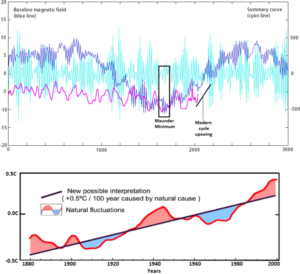by V. Zharkova & I. Vasilieeva, Nov 2023
Abstract: This paper explores the links between terrestrial temperature, sea levels and ice areas in both hemispheres with solar activity indices expressed through averaged sunspot numbers together with the summary curve of eigen vectors of the solar background magnetic field (SBMF) and with changes of Sun-Earth distances caused by solar inertial motion resulting from the gravitation of large planets in the solar system.
Using the wavelet analysis of the GLB and HadCRUTS datasets two periods: 21.4 and 36 years in GLB, set and the period of about 19.6 years in the HadCRUTS are discovered. The 21.4 year period is associated with variations in solar activity defined by the summary curve of the largest eigen vectors of the SBMF. A dominant 21.4-year period is also reported in the variations of the sea level, which is linked with the period of 21.4 years detected in the GLB temperature and the summary curve of the SBMF variations. The wavelet analysis of ice and snow areas shows that in the Southern hemisphere it does not show any links to solar activity periods while in the Northern hemisphere the ice area reveals a period of 10.7 years equal to a usual solar acitviity cycle.
The TSI in March-August of every year is found to grow with every year following closely the temperature curve, because the Sun moves closer to the Earth orbit owing to gravitation of large planets. (solar inertial motion, SIM). While the variations of solar radiation during a whole year have more steady distribution without a sharp TSI increase during the last two centuries. The additional TSI contribution caused by SIM is likely to secure the additional energy input and exchange between the ocean and atmosphere.
Link to pre-print: https://solargsm.com/wp-content/uploads/2023/11/zharkova_tsi_nc_form_subm-1.pdf
The paper is accepted for publication.




